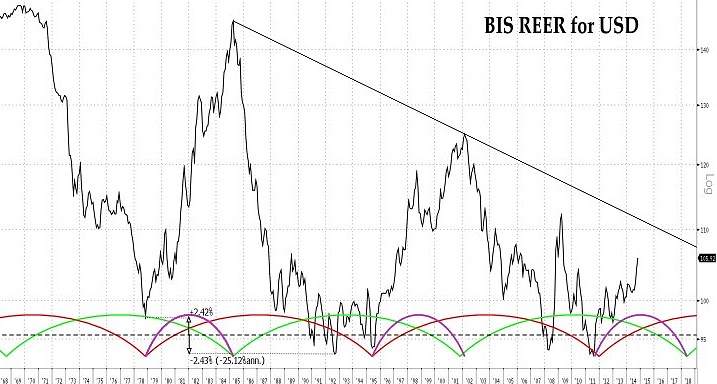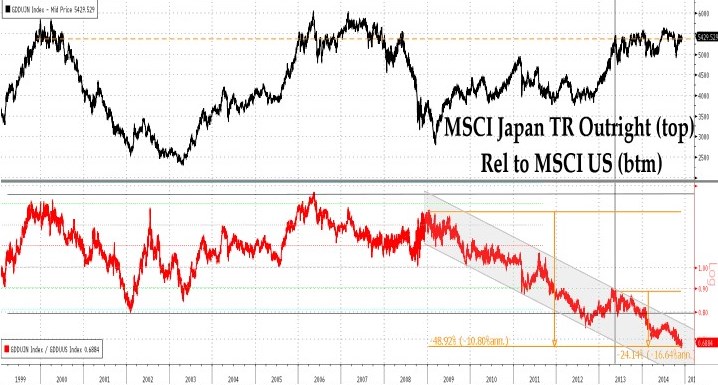It is rare these days to come across an investment manager or a strategist who will not proudly volunteer that he is either ‘Long the Nikkei, short the Yen,’ or is telling his clients to position themselves that way.
With all due caveats about crowded trades and the like, we cannot find the second part of this at all objectionable, having long been promoting the view that the USD would do what it has repeatedly done (in real effective rate terms) ever since the break up of the Gold Pool in 1968 signalled the imminent end of the Bretton Woods system – namely, decline then base out over the course of a decade to a point within +/- 2 1/2% of the same base level (95.5 on the BIS index), then reverse and rally for the next 6 1/2 years.
On that scenario, just as late 1978 marked the inauguration of the Volcker-Reagan ‘SuperDollar’ (which topped with the Plaza Accord in 1985) – and just as early 1995 saw the post-Tequila low and the Sakakibara rally which effectively petered out under the trifecta of influences exerted by the geopolitical upheaval suffered in the wake of 9/11, the first flush of enthusiasm for the newborn euro, and the subsequent ‘opening up’ of China via its WTO accession – so, too, did the second half of 2011 reinstitute the US as the default destination for the world’s surplus financial capital given the cessation of China’s vast reflation, the dislocation of the Fukushima disaster in Japan, and the outbreak of the Target2 wars and Draghi’s ‘whatever it takes’ palace coup in Frankfurt.
On that form, the present rally should last until the first half of 2018 and a higher dollar implies a lower yen, even without the implacable folly that is Kuroda’s and Abe’s intent to relieve their fellow citizens of their savings by stealth.
No, it is the first leg of the trade that makes no sense to us for the ugly truth is that, after an initial lurch upwards, the Nikkei – when measured in USD – has made absolutely no further progress this past eighteen months and has therefore underperformed a rampant US market by a quarter (and by a half since the LEH crash itself).
Nor does fixed income offer much hope for all that the BOJ has managed to push bond futures to new all-time highs. The EFFA total return index – when measured in USD – has hit a 4 1/2 year low, wiping out all gains since the end of 2008. Compared to its UST equivalent it has slipped 26% since last November and 42% since the middle of 2011.
All gains in these trades when hedged are at root derived from (a) the bond-buying means by which the yen is being deliberately depressed and (b) the translational effect of unchanged foreign earnings upon a depreciation-reduced equity base among the exporters.
Why, therefore, as a non-Japanese domiciled investor in the Nikkei, you would wish to run even the slenderest of tail risks of the country suffering a systemic melt-down if it persists in its present course or, conversely, incur the hazard that a wrenching reversal – and a concomitant asset price collapse – is forced upon the authorities at some not-too distant juncture, all for zero absolute reward and all the while taking a positive pasting in relative performance, is a matter you really should discuss with your shrink!
NB The foregoing is for educative and entertainment purposes only. Nothing herein should be construed as constituting investment advice. All rights reserved. ©True Sinews



